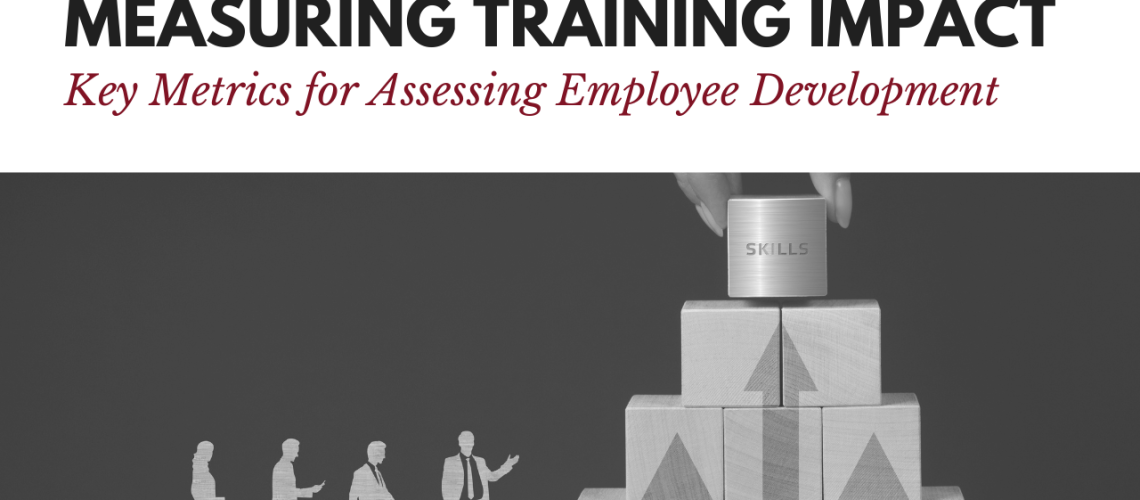By Dr. Salam Slim Saad
Are you investing in employee development but unsure if it’s truly making an impact? Do you want to measure the effectiveness of your training programs and ensure they are driving noticeable results?
Training is an investment—a promise of results. To evaluate the return on that investment, you not only need to know what training was conducted, but also how it impacted your organization.
The goal of any business is to achieve a competitive advantage in the marketplace. Developing your employees’ skill sets and knowledge can help you get there. A critical component lies in measuring training impact, which can help you make decisions on effective training strategies and identify where more effectiveness is needed for addressing current skill gaps. Employees are the company’s greatest asset, so understanding how to maximize the potential of this resource can have a significant effect on the bottom line.
What Are Training Evaluation Metrics?
Training evaluation metrics are specific measurements and indicators used to assess the effectiveness and impact of employee development programs. These metrics provide valuable insights into the success of training initiatives, helping organizations understand if their investments in learning and development are delivering desired outcomes.
From a broader perspective, training evaluation metrics serve as key performance indicators (KPIs) that enable companies to measure the return on investment (ROI) of their training programs. By tracking these metrics, businesses can evaluate whether employees are acquiring new skills, enhancing their existing competencies, and ultimately improving their overall performance.
There is no one-size-fits-all approach when it comes to selecting training evaluation metrics. The choice of metrics depends on various factors such as organizational goals, learning objectives, and the nature of the training program itself. However, some common types of evaluation metrics include learner satisfaction surveys, knowledge assessments before and after training courses, skill enhancement measurements through practical tests or simulations, feedback from supervisors or managers regarding changes in employee behavior or productivity levels post-training.
These comprehensive evaluations go beyond just measuring knowledge retention; they focus on measuring behavioral changes resulting from the training as well. This allows organizations to gauge whether employees have successfully implemented what they learned during the program into their day-to-day work activities.
In essence, effective training evaluation requires a combination of qualitative data (such as surveys or interviews) and quantitative data (such as test scores or performance metrics). By analyzing these different types of data points together over time – both immediately after completion of a course and in longer-term follow-up periods – businesses gain a holistic understanding of how well their employee development efforts align with organizational goals.
Why Are Corporate Training Metrics Important?
Corporate training metrics are crucial for assessing the effectiveness and impact of employee development programs. They provide valuable insights into the outcomes and benefits of training initiatives, helping organizations make informed decisions about future investments in learning and development.
One key reason why corporate training metrics are important is that they help measure the return on investment (ROI) of training programs. By tracking metrics such as increased productivity, improved performance, and enhanced skills among employees, organizations can determine whether their training efforts are generating tangible results.
Furthermore, these metrics enable companies to identify areas where additional support or improvement may be needed. For example, if certain learning objectives consistently fall short in terms of employee mastery or competency development, it signals a need to refine the content or delivery methods used in those areas.
Additionally, corporate training metrics play a vital role in aligning learning outcomes with business goals. By measuring how effectively employees apply newly acquired knowledge and skills on the job, organizations can ensure that their training initiatives directly contribute to overall organizational success.
Moreover, tracking these metrics enables companies to assess employee engagement levels during the training process. This insight helps organizations gauge how well their employees are responding to different types of development opportunities and identify ways to enhance engagement for better learning outcomes.
Corporate training metrics serve as a critical tool for evaluating the impact of employee development programs. Through consistent measurement and analysis of key performance indicators (KPIs), organizations can continuously refine their strategies and improve both individual growth prospects and overall business performance.
12 Training Metrics To Measure
Measuring the effectiveness of training programs is crucial for organizations to ensure that their investment in employee development is yielding positive results. There are many different training metrics that you can use to measure the effectiveness of your programs. Here are 12 of the most important:
- Enrollment Count: Tracking the number of participants enrolled in your training programs provides insights into the popularity and demand for different training offerings. This information can guide decisions on resource allocation and future training offerings.
- Rate of Training Completion: The training completion rate is a fundamental metric that indicates the percentage of trainees who successfully complete the training program. A high completion rate suggests that the training content is engaging and relevant to the learners.
- Rate Of Participant Drop-Off: On the flip side, the trainee drop-off rate highlights the number of participants who start the training but do not complete it. Monitoring this metric can help you identify potential pain points in the training content or delivery method that might be causing trainees to lose interest.
- Rate of Successful Assessments: Assessment pass rate measures the percentage of trainees who successfully pass the assessments or tests after completing the training. A high pass rate indicates that the training content effectively conveys the required knowledge and skills.
- Employee Input and Feedback: Gathering feedback from trainees about the training experience is crucial. This can be done through surveys, focus groups, or informal discussions. Employee feedback provides insights into what’s working well and areas that need improvement in the training programs.
- Level of Trainee Engagement: Engagement rate tracks how actively participants interact with the training content. This metric considers factors like time spent on each module, interactions with quizzes, and engagement with multimedia elements. High engagement rates suggest that the training content is interesting and holds the learners’ attention.
- Indicators of Key Performance (KPIs): Key Performance Indicators are specific and measurable goals that tie directly to the learning outcomes of the training program. Tracking KPIs helps you assess the impact of training on employees’ performance and the overall success of the organization.
- Post-training Performance: Measuring the change in employees’ performance after completing the training is a strong indicator of training effectiveness. Whether it’s increased sales, improved customer satisfaction, or enhanced technical skills, observing these changes demonstrates the practical value of your training efforts.
- Employee Cost Analysis: Calculating the cost per employee trained is essential to ensure that your training initiatives are cost-effective. This metric involves considering expenses related to content development, trainers, technology, and other training-related costs.
- Operational Effectiveness: Operational effectiveness metrics help evaluate how training impacts the overall efficiency of the organization. This could include metrics such as reduced error rates, faster task completion times, or streamlined processes.
- Instruments and Tools Used: In today’s digital age, knowing which devices participants use to access training materials can help optimize content delivery. Understanding whether trainees prefer mobile devices, laptops, or desktops can influence how you design and deliver your training materials.
- Return on Investment (ROI): The return on investment metric evaluates the financial benefits gained from the training program compared to the costs incurred. ROI helps demonstrate the tangible value of training and justifies the resources invested.
By tracking these metrics, you can get a better understanding of the effectiveness of your training programs. This information can help you to improve your training programs and to ensure that they are meeting the needs of your learners and your organization. Here are some additional tips for measuring the effectiveness of your training programs:
- Use a variety of metrics to get a well-rounded view of the results.
- Collect data over time to track trends.
- Compare your results to industry benchmarks.
- Use the data to make improvements to your training programs.
By measuring the effectiveness of your training programs, you can ensure that they are providing your learners with the skills and knowledge they need to succeed.”
A Final Word
The right training and development strategies, implemented at the right time, for the right employee can have a tremendous impact on your organization.
Training today is no longer a matter of ‘if’ organizations should invest in it, but rather, ‘how’ to consistently improve training well after its introduction. The key to effective training is measuring how it fits into the organization’s strategy and aligning learning programs with business demands. The goal of all training and development is to maximize the impact on the bottom line, which ultimately increases their return on investment. With the right tools and strategies in place, companies can begin to identify what learning has been effective for their employees across different departments and business divisions.
As we navigate the ever-evolving landscape of business and learning, the significance of measuring training impact becomes more evident than ever. Imagine a future where every training initiative is optimized for success, every skill acquired contributes directly to your company’s growth, and every investment in your employees yields exponential returns. By consistently assessing training’s effects, we can move closer to that vision. So, let’s initiate this process of continuous improvement, where the question isn’t just ‘how,’ but also ‘what more can we achieve?’ The path to exceptional employee development and organizational success is illuminated by our commitment to measuring, adapting, and advancing.



